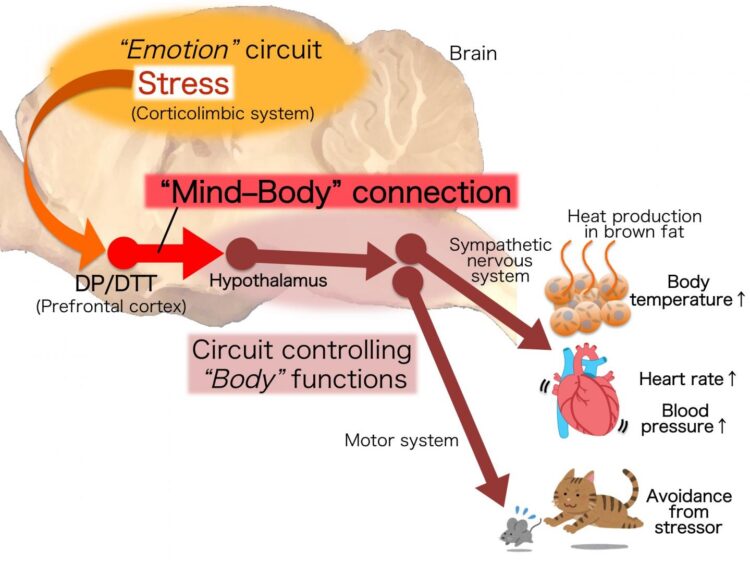This circuit could be a key target for treating stress-related disorders such as panic disorder and PTSD.

Credit: Kazuhiro Nakamura
Researchers at Nagoya University have discovered a neural circuit that drives physical responses to emotional stress. The circuit begins in deep brain areas, called the dorsal peduncular cortex and the dorsal tenia tecta (DP/DTT), that send stress signals to the hypothalamus, a small region in the brain that controls the body’s vital functions. The findings were recently published in the journal Science.
Emotional stress activates the sympathetic nervous system, which leads to physical responses, such as a rise in blood pressure and body temperature, and a faster heart rate. Such responses are thought to be coping mechanisms in humans and many other mammals to boost physical performance in fight-or-flight situations. But nowadays, when most people rarely encounter such situations, these responses could perhaps have an adverse effect on their health. Excessive stress may cause symptoms such as psychogenic fever, a condition of abnormally high body temperature.
To develop strategies for treating stress-induced symptoms, the neural mechanism underlying physical responses to stress had first to be understood. To this end, a research team led by Professor Kazuhiro Nakamura and Designated Assistant Professor Naoya Kataoka, of the Nagoya University Graduate School of Medicine, conducted a study in which tracers were injected into the brains of a group of rats and the rats were subjected to a stressful event (rat bullying by a dominant rat).
The tracers showed that specifically the DP/DTT brain areas were highly active when exposed to stress. To further examine the role these brain areas have in stress response, the researchers impaired the areas’ connections to the hypothalamus and again exposed the rats to the same stress. Now the rats did not exhibit any stress-induced physical response, neither a rise in blood pressure nor body temperature, nor a faster heart rate.
This study demonstrates that the DP/DTT areas together are responsible for sending stress signals to the hypothalamus, and thus that blocking the DP/DTT-to-hypothalamus circuit can result in a reduction of stress symptoms in rats.
Professor Nakamura sums up the research result like this: “The DP/DTT are parts of the brain that are involved in processing emotion and stress. The DP/DTT-to-hypothalamus pathway we discovered, therefore, represents a brain mechanism for a ‘mind-body connection,’ which can be a potential target for treating stress-related disorders such as panic disorder, post-traumatic stress disorder (PTSD), and psychogenic fever.”
###
The paper, “A central master driver of psychosocial stress responses in the rat,” was published in the journal Science on March 6, 2020 at DOI: 10.1126/science.aaz4639.
Authors:
Naoya Kataoka, Yuta Shima, Keisuke Nakajima, and Kazuhiro Nakamura
Department of Integrative Physiology, Nagoya University Graduate School of Medicine
About Nagoya University, Japan
Nagoya University has a history of about 150 years, with its roots in a temporary medical school and hospital established in 1871, and was formally instituted as the last Imperial University of Japan in 1939. Although modest in size compared to the largest universities in Japan, Nagoya University has been pursuing excellence since its founding. Six of the 18 Japanese Nobel Prize-winners since 2000 did all or part of their Nobel Prize-winning work at Nagoya University: four in Physics – Toshihide Maskawa and Makoto Kobayashi in 2008, and Isamu Akasaki and Hiroshi Amano in 2014; and two in Chemistry – Ryoji Noyori in 2001 and Osamu Shimomura in 2008. In mathematics, Shigefumi Mori did his Fields Medal-winning work at the University. A number of other important discoveries have also been made at the University, including the Okazaki DNA Fragments by Reiji and Tsuneko Okazaki in the 1960s; and depletion forces by Sho Asakura and Fumio Oosawa in 1954.
Media Contact
Kazuhiro Nakamura
[email protected]
Original Source
http://en.
Related Journal Article
http://dx.





